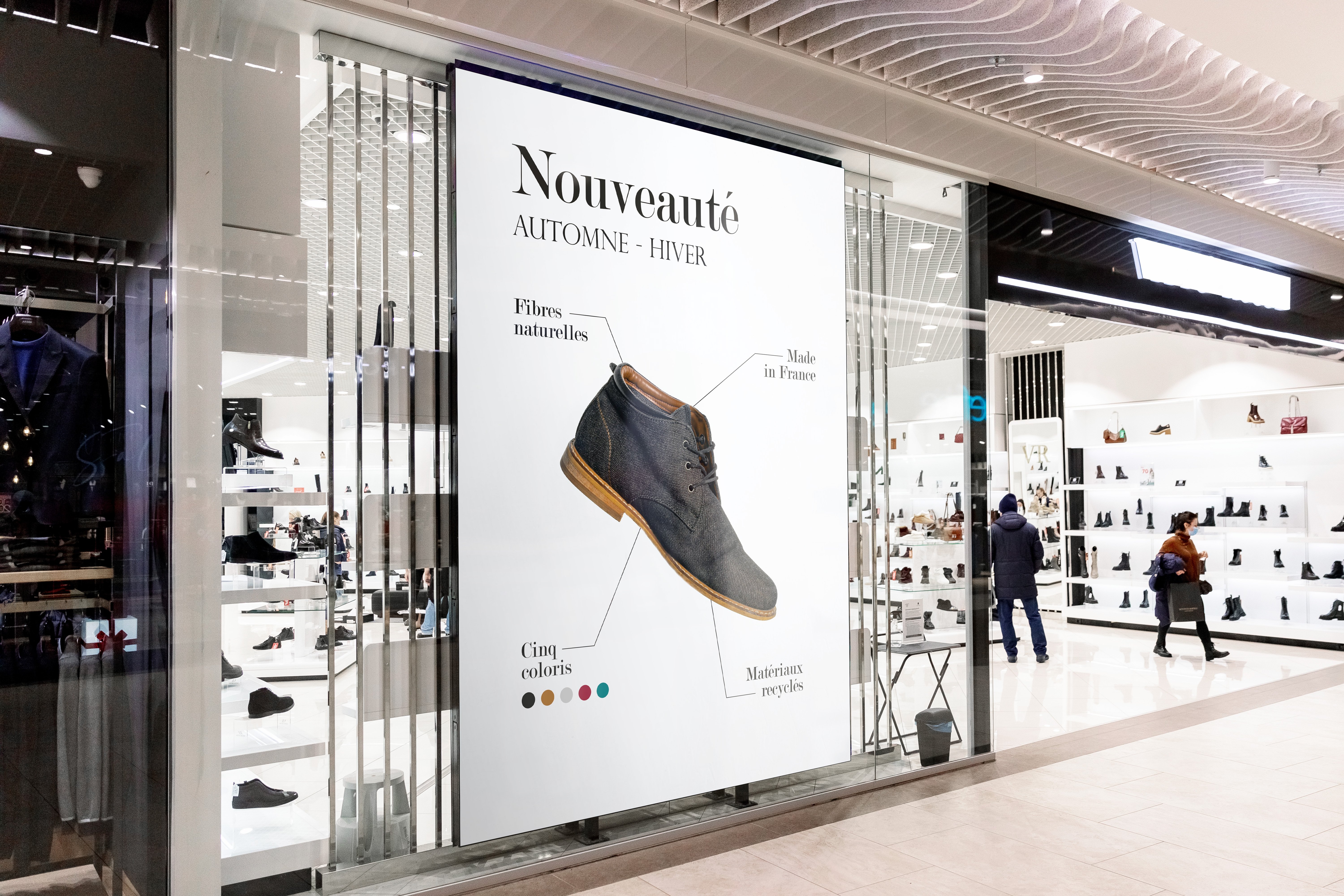
Let's go through the main criteria to take into account when choosing a digital window display screen suitable for a digital signage project. The goal? Promote your brand while offering the best retail customer experience.
1. Opt for high brightness
First of all, you should know that the brightness of a screen is measured in candela per m2 (cd/ m2) or in Nits. This brightness criterion is also one of the most important when choosing your digital window display screen. Indeed, a showcase is subject to significant variations in brightness, especially when exposed to the sun at certain times of the day.
While the standard brightness of a standard consumer TV is around 300 to 400 cd/ m2, restricting it to indoor use, a display window display screen offers values up to 4000 cd/ m2 that allow it to overcome the constraints of brightness.
Some dedicated window display screens use integrate brightness sensors to adapt the intensity of lighting according to the time of day, either according to ambient light or a day/night mode. If your digital display window does not have one, it is still possible to use external sensors.
2. Consider display time
Screen display time directly affects its lifespan. This is especially true for a digital display screen that must be able to operate for long hours without performance loss or overheating.
Most LED digital displays have an average lifespan of 50,000 hours. While this may seem like a lot at first, it amounts to only 5 years of continuous operation.
If your digital window display screen is constantly on, it is therefore advisable to invest in models specially designed for intensive use, even if this implies a higher initial cost.
3. Choose a suitable screen size
The digital screen size, but also the distance from which you need to capture attention, are factors to consider to feature high-impact promotions. They determine the ideal format for your digital signage screen. The goal? Simply optimize the readability of your content.
In some cases, an area can sometimes be determined rather than a specific distance, as the flow of passers-by can be of multiple directions.
Beyond the size of the digital window display screen, also ensure the readability of your advertising messages. By optimizing the size of the images, selecting a suitable font or integrating video formats, you will put all the chances on your side to maximize the impact of your showcase with customers. The goal? Invite them into your store.
4. Understanding the main technologies
Digital signage manufacturers mainly offer LCD (Liquid Crystal Display) and LED (Light Emitting Diode) displays.
The screens with LCD technology
TN Panel LCD
The «TN» display panel is a bit the standard of the LCD screen: it is very widespread on the market thanks to its excellent quality/ price ratio. Its great luminosity gives it a use perfectly adapted to the windows of the points of sale.
Regarding the disadvantages, it should be noted that the contrast is limited with a black that lacks depth. If your graphic charter gives pride of place to dark colors, this technology is probably not the most suitable. Finally, the viewing angle is also limited.
IPS Panel LCD
The «IPS» display panel is increasingly popular in the digital signage world. It always offers high brightness while offering very wide viewing angles. The rendering and homogeneity of the colors is also superior to a «TN» slab.
However, the responsiveness and contrast are still somewhat limited. You should also know that these tiles are sensitive to blooming, the halo effect of light that appears around your elements when they are placed in dark areas.
VA Panel LCD
Let’s finish with the «VA» slab for «Vertical Alignment». Its strength? The contrast! Blacks and colors are much deeper, thus scrubbing one of the major drawbacks of LCD technology. The viewing angles also remain wide.
So where are the disadvantages? Mainly on the response time that remains less than a slab «TN».
LED screens
The LED screen
LED screens are known to offer high brightness and a wide viewing angle as standard, all without compromising image quality. These screens often benefit from a more careful aesthetic because they are thinner. They are therefore less cumbersome but also less heavy.
The contrast is interesting, with deep blacks and clear colors. On the power consumption side, it is less than an equivalent range LCD display and they emit less heat.
OLED
While the LED screen illuminates liquid crystals with groups of diodes, the OLED (Organic Light-Emmiting Diode) screen has a light source for each pixel. By turning off or turning on each pixel individually, you get a much better contrast and unparalleled image accuracy: black becomes an absolute black, the colors are intense and the finesse of the details is incomparable.
Regarding viewing angles and reactivity, again cardboard full. We can also note the absence of blooming. Watch out for the brightness that was historically a bit low but is now becoming at the level of other technologies.
5. Verify Energy Consumption
The power consumption of a display screen depends on many factors, the first being its quality. While offering economic products is a major challenge for component manufacturers, they must nevertheless invest heavily in research and development. This R&D time has a direct impact on the selling price of a showcase screen. With equivalent technology, we generally observe higher consumption on entry-level screens compared to premium display screens.
The power consumption of a display screen is of course also related to the chosen technology. For example, LED technology offers a 30% lower consumption than an LCD screen. Beyond the purely technical data sheets, we must be aware that use has a direct impact on consumption. We optimize the light intensity and comply with the regulations by turning off the screen.
6. Do not neglect the display mount
The display screen support is sometimes overlooked, yet it also plays a role in the success of a digital signage project. Choose an adjustable stand that offers different adjustment options.
Think about the fact that the window layout can evolve and therefore the position of your screen too. It will be comfortable to be able to adjust the height of the digital display screen or its angle of diffusion to optimize the visibility of information.
How to buy a digital screen?
Many audiovisual professionals are present on the market, whether hardware integrators, wholesalers, resellers or manufacturers.
If we do not directly offer digital window display screens, we nevertheless collaborate with a network of distributors carefully selected for the quality of their solution to propose turnkey digital signage and interactive projects including software, equipment and services, for the showcase of your business.



